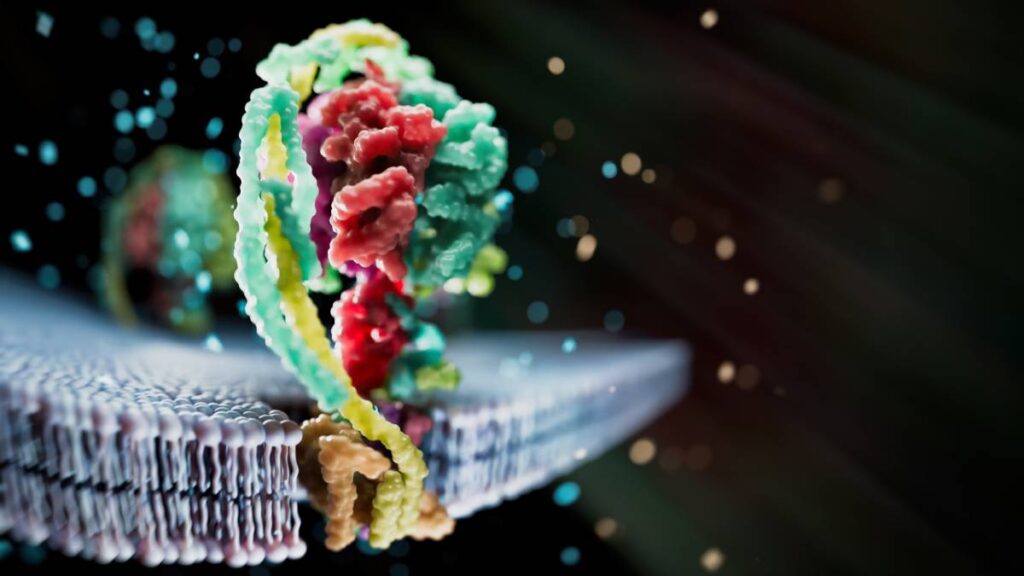Pancuronium is a long-acting, non-depolarizing neuromuscular blocking agent that plays a significant role in anesthesia and critical care by inducing skeletal muscle relaxation. Pancuronium’s primary mechanism of action involves the competitive antagonism of acetylcholine at nicotinic receptors located at the neuromuscular junction. Typically, acetylcholine, which is released from presynaptic nerve terminals, binds to postsynaptic nicotinic receptors. This triggers sodium influx, depolarization, and thus muscle contraction. Pancuronium interrupts this process by occupying the same receptor sites without activating them, thereby preventing acetylcholine from initiating depolarization and blocking neuromuscular transmission (1).
The molecular design of pancuronium is based on a steroid backbone with two quaternary ammonium groups. These positively charged sites mimic the structure of acetylcholine, enabling pancuronium to fit into the receptor binding pocket. However, unlike acetylcholine, pancuronium cannot trigger the conformational change needed to open the ion channel. Consequently, the receptor remains closed, and no depolarization occurs. This “silent binding” makes pancuronium a competitive antagonist, and its effect can be overcome clinically by increasing acetylcholine levels with acetylcholinesterase inhibitors, such as neostigmine (2).
Pancuronium is distinguished from other neuromuscular blockers by its relatively slow onset and long duration of action. Paralysis often persists for 60 to 90 minutes after a single dose. These characteristics make it ideal for lengthy surgical procedures but less ideal for situations requiring rapid recovery. After administration, the drug undergoes partial hepatic metabolism, and most of the parent compound and its active metabolites are cleared by the kidneys. In patients with impaired kidney function, this dependence on renal excretion can lead to prolonged blockade. Thus, careful dosing and close monitoring are necessary to avoid delayed recovery of muscle strength (3).
Unlike depolarizing agents such as succinylcholine, pancuronium’s mechanism of action does not involve receptor activation, and as a result, it does not cause muscle fasciculations. This makes pancuronium more predictable and generally well tolerated. Importantly, pancuronium is associated with minimal histamine release, which reduces the risk of hypotension or bronchospasm seen with some other neuromuscular blockers. However, pancuronium has vagolytic properties, meaning it can block cardiac muscarinic receptors. This can lead to tachycardia and mild increases in blood pressure. While this effect can be beneficial in counteracting anesthetic-induced bradycardia, it may pose risks to patients with preexisting cardiovascular disease (4).
Another important consideration when using pancuronium is the potential for residual neuromuscular blockade during the postoperative period. Since the drug and its active metabolites can persist, especially in patients with renal impairment, patients may experience delayed recovery of muscle strength and impaired airway protection if they are not properly monitored. To mitigate this risk, anesthesiologists often use train-of-four (TOF) stimulation to assess the level of blockade remaining. In this technique, a peripheral nerve is stimulated four times in rapid succession, and the resulting muscle twitches are observed or measured. A fade in the twitch response indicates incomplete recovery from blockade. This simple yet effective tool allows clinicians to adjust dosing, evaluate recovery, and determine the timing of reversal agents, such as neostigmine, which increase acetylcholine levels, thereby competing with pancuronium for the receptor. These measures reflect how pancuronium’s molecular mechanism translates directly into clinical practice, making careful dosing, monitoring, and reversal essential for patient safety.
References
- Bowman WC. Neuromuscular block. Br J Pharmacol. 2006;147 Suppl 1(Suppl 1):S277-S286. doi:10.1038/sj.bjp.0706404
- Foldes FF. The rational use of neuromuscular blocking agents: the role of pancuronium. Drugs. 1972;4(3):153-162. doi:10.2165/00003495-197204030-00001
- McLeod K, Watson MJ, Rawlins MD. Pharmacokinetics of pancuronium in patients with normal and impaired renal function. Br J Anaesth. 1976;48(4):341-345. doi:10.1093/bja/48.4.341
- Martyn JAJ, Sparling JL, Bittner EA. Molecular mechanisms of muscular and non-muscular actions of neuromuscular blocking agents in critical illness: a narrative review. Br J Anaesth. 2023;130(1):39-50. doi:10.1016/j.bja.2022.08.009
